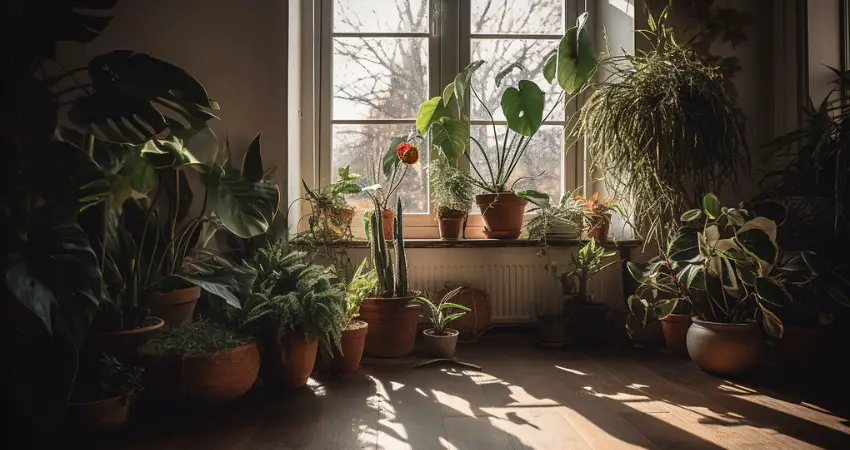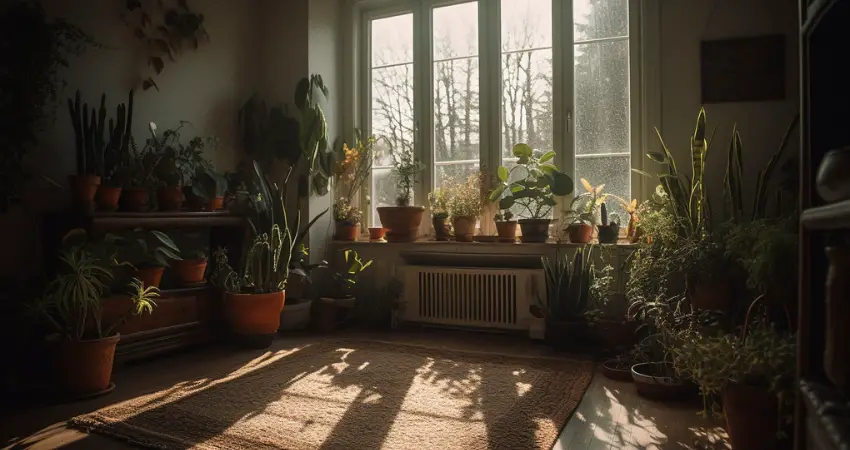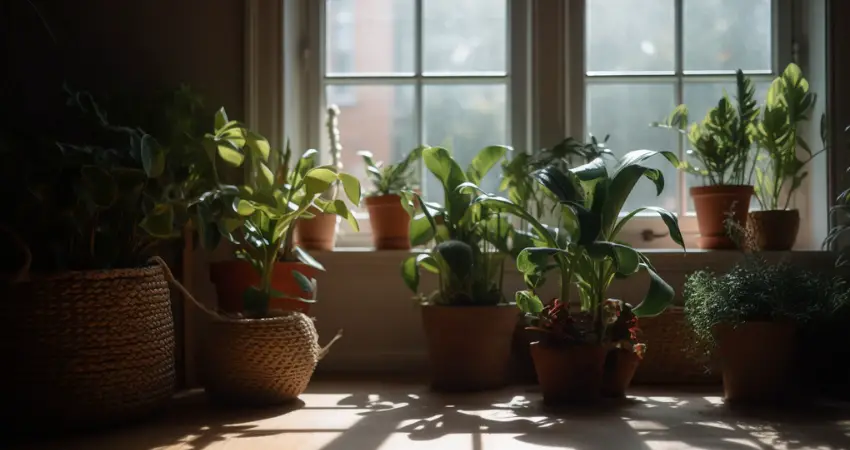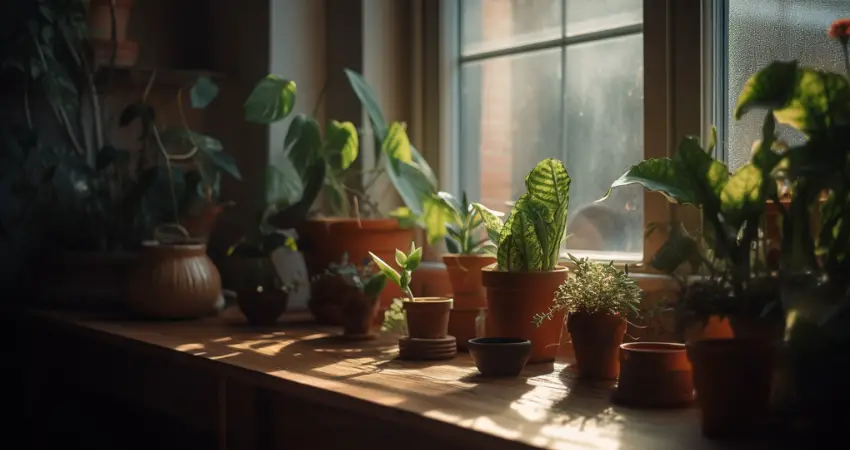Embark on a journey to the lush world of indoor flora, where we unravel the secrets of proper plant rotation for balanced light exposure, ensuring that your leafy companions flourish in their cozy nooks. While nature takes care of outdoor plants with ever-changing light angles, our indoor greenery relies on us to mimic this crucial aspect of their growth.
As indoor plants reach out to their light source in a bid to optimize energy for growth, neglecting to rotate them can result in unsightly asymmetry and weakened structure. By incorporating regular rotation into your plant care routine, you can enhance the aesthetics and health of your plants, making them more resistant to diseases and pests.
In our enlightening exploration, we’ll delve into the key factors affecting light exposure for indoor plants, including window direction, plant type, and seasonal changes. With this knowledge, you’ll soon become a plant-whisperer, capable of fostering symmetrical growth and vibrant vitality in your indoor garden.
Importance of Rotating Houseplants

Rotating your indoor plants is essential to ensure even light exposure and achieve symmetric growth. When plants are placed outdoors, they receive light from different angles throughout the day. However, for indoor plants, you must simulate this effect by manually rotating them.
Plants naturally lean towards their light source as a survival technique to get more energy for growth (Keep Your Plants Alive). If you do not rotate your indoor plants, they may develop an uneven or twisted appearance. Regular rotation helps your plants maintain their aesthetic, preventing them from looking strange.
Apart from enhanced aesthetics, proper light exposure promotes healthy growth, ensuring that all parts of the plant receive sufficient light (Flourishing Plants). This balanced growth leads to stronger and healthier plants, making them more resilient to diseases and pests.
To achieve these benefits, it’s crucial to incorporate plant rotation into your plant care routine. By doing so, you’ll promote symmetrical growth and contribute to the overall health and beauty of your indoor plants.
Factors Affecting Light Exposure
Several factors affect the light exposure of your indoor plants. In this section, we will discuss three main factors: window direction, plant type, and seasonal changes.
Window Direction
The direction of the window in which your plant is placed plays a crucial role in determining its light exposure. Each window orientation offers different lighting conditions throughout the day:
- South-facing windows: These provide the strongest light, offering consistent sunlight throughout the day. Place sun-loving plants in this area, such as succulents or flowering plants.
- East-facing windows: Morning sunlight is available here, which is typically softer and cooler. This is ideal for low to medium light plants like pothos and ferns.
- West-facing windows: Afternoon sunlight, which can be intense and warm, is the main source of light for this orientation. Choose plants that can tolerate direct or bright indirect light, like ZZ plants or rubber plants.
- North-facing windows: Least amount of direct sunlight, making it suitable for plants that prefer low light conditions, such as snake plants or peace lilies.
Plant Type
Different plants have varying light requirements, which can affect how often you need to rotate them for even exposure. For example, plants that thrive in indirect light, like pothos, require rotation more frequently, about once a week. On the other hand, sun-loving plants like succulents may need rotation less often, as they usually receive plenty of intense light.
Seasonal Changes
The changing seasons also impact the amount and quality of sunlight that your plants receive. During the winter months, daylight hours are shorter, and the angle of the sun is lower, causing a reduction in overall light intensity. This may require you to move your plants closer to the window or adjust their rotation schedule to compensate for the reduced light availability.
Conversely, during the summer months, sunlight is more abundant and intense, so you may need to adjust the positioning of your plants to prevent sunburn or excessive light exposure.
Houseplant Rotation Techniques

Having a proper rotation technique for your indoor plants is essential to ensure even light exposure and balanced growth. In this section, we’ll discuss a few techniques you can use to achieve this.
Simple Rotation Method
The most straightforward method is to rotate your plants manually. This can be done by turning the pot of the plant every week, or more frequently if necessary, to even out the light distribution.
A good rule of thumb is rotating the plant by approximately 45 degrees each time you water it, to ensure equal exposure of all sides to sunlight. To remember which direction you’re rotating, you can use a small marker or a piece of masking tape on the pot to indicate the front of the plant; simply move it around as you rotate your plants. A good time to turn your potted plants is when you are watering them.
Using Reflective Surfaces
Another technique is the use of reflective surfaces around the plants. You can place mirrors or whiteboards on the side of the plant opposite to the light source. The reflective surfaces help distribute light towards the shaded parts of the plant, providing more balanced growth without excessive rotation.
You can also use aluminum foil, which is an inexpensive and readily available option, to achieve the same effect by wrapping it around a piece of cardboard and positioning it near the plant for better light distribution.
Adjusting Plant Positions
Lastly, repositioning your plants can sometimes help to ensure even light exposure. If some plants are getting too much light while others are struggling, try switching their positions.
Moving them within their growth zone can help them achieve more balanced light exposure. For instance, if a plant is leaning too much towards the light, you may want to move it to a higher spot or closer to the window.
Alternatively, if a plant is suffering from too much light, move it to a slightly shadier location or farther from the window. Analyzing and adjusting the plants’ positions within their growth zones can resolve many uneven light exposure issues without even needing to turn them manually.
How Often Should You Turn A Houseplant

The frequency of rotation depends on the light requirements of your plant. If your plant loves sunlight, it’s recommended to turn it every 2-3 months. For plants that require low or medium light, rotate them every few weeks or once a month.
One practical approach to keeping up with plant rotation is to give your plant a quarter turn every time you water it (source). This method ensures a consistent schedule and prevents you from over- or under-rotating the plants.
Rotating your plants regularly is important because it allows all sides of the plant to receive equal amounts of sunlight, promoting balanced growth and a more symmetrical appearance. Over time, this practice helps improve the health and aesthetics of your houseplants.
What Happens if a Plant Doesn’t Get Rotated
When your indoor plants don’t get rotated, they may experience uneven growth and develop a lopsided appearance. This is because the side facing the light source gets more exposure and grows faster, while the other side receives less light and grows slower.
Another consequence of not rotating indoor plants can be increased susceptibility to diseases and pests. When the plant is stretched towards the light source, it may become weaker and less capable of fighting off potential threats. Moreover, stagnant air and humidity around the less exposed side can create a conducive environment for mold, mildew, and certain pests to thrive.
Besides affecting the plant’s appearance and health, a lack of rotation can limit the amount of light exposure and photosynthesis occurring in the plant. This, in turn, may affect the overall growth and vitality of the plant, leading to a slower and less vibrant development.
Therefore, regularly rotating your indoor plants helps ensure:
- Even growth and balanced appearance
- Better light exposure and photosynthesis
- Improved air circulation and overall health
- Reduced chances of pests and diseases
To keep your indoor plants healthy and well-balanced, be sure to rotate them frequently, allowing all sides to receive equal amounts of light and air circulation.
Monitoring Plant Health

Keeping an eye on your indoor plants’ health is essential for ensuring they receive even light exposure. In this section, we will discuss the signs of uneven light exposure and how to make adjustments accordingly.
Signs of Uneven Light Exposure
Identifying the symptoms of uneven light exposure can help you take appropriate corrective measures in a timely manner. Some common signs include:
- Leaning or bending towards the light source
- Uneven growth patterns
- Yellowing or discoloration on the shaded side of the plant
- Stunted growth or legginess on the side facing away from the light
These symptoms indicate that your indoor plants are not receiving equal amounts of light on all sides, which can lead to imbalanced growth and overall poor health.
Making Adjustments
To rectify this issue, you should consider rotating your houseplants regularly to ensure even light exposure. If needed, you can perform a 90-degree rotation once a month for plants in balanced light conditions. For plants in lower light conditions, a 45-degree turn every one to two weeks is recommended to prevent uneven defoliation and discoloration.
Another solution is placing a fluorescent light on the shaded side of the plant, promoting even growth without the need for window access. Alternatively, consider adjusting the position of the plant or the light source to provide more balanced light distribution.
Monitoring your indoor plants’ health and performing these adjustments as needed will result in healthier, more attractive plants that thrive with uniform light exposure.
Bottom Line
In conclusion, the art of plant rotation is indispensable for ensuring your indoor plants receive balanced light exposure, promoting symmetrical growth and a healthier, more attractive appearance. By rotating your plants regularly, adjusting their positioning, and monitoring their health, you will foster a thriving indoor garden that radiates vibrant vitality.
Don’t hesitate to experiment with different techniques and arrangements, as each plant is unique in its requirements. With time and dedication, you’ll become a true indoor plant connoisseur, creating a lush, harmonious haven for your leafy companions.
